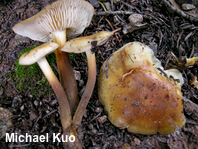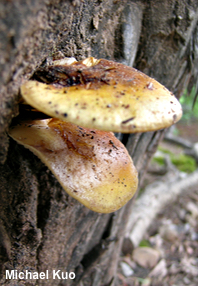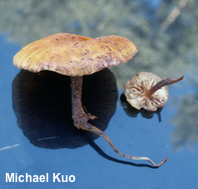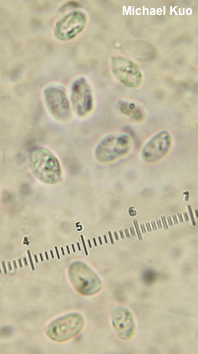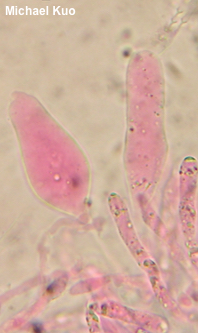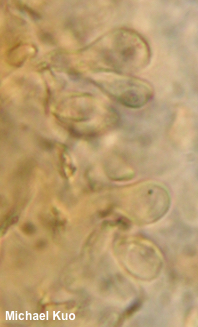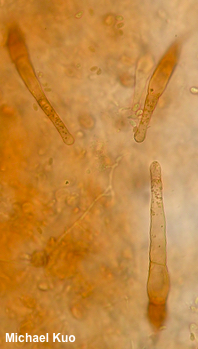| Major Groups > Gilled Mushrooms > Pale-Spored > Collybioid > Flammulina populicola |

|
[ Basidiomycota > Agaricales > Physalacriaceae > Flammulina . . . ] Flammulina populicola by Michael Kuo, 1 May 2024 Like its better-known relative, Flammulina velutipes, Flammulina populicola has a fuzzy brownish stem, a white spore print, and a sticky, reddish brown to orangish brown cap. But there are five crucial things that separate the two species:
All of this means that Flammulina populicola is a separate species no matter how you define a "species," since the three most widely recognized "species concepts" for fungi are covered. It is a biological species because it can only mate with other Flammulina populicola specimens. It is a morphological species because it has observable physical features that separate it (though the features are microscopic). And it is a phylogenetic species because its DNA separates it. And, as is often the case, the mushroom's ecology appears to separate it, as well. It has evolved with the western poplars, and not in other North American ecosystems. Mushroom identifiers who lack DNA sequencers, fungal culture labs, and microscopes may be able to identify it with confidence on this basis alone. Description: Ecology: Saprobic on the stumps, logs, roots, and living wood of poplars (members of the genus Populus, like quaking aspen and narrowleaf cottonwood); growing alone, scattered, gregariously, or (more commonly) in clusters; often appearing terrestrial when growing from root systems; late summer and fall (common during monsoon season in the Rockies); originally described from California (Redhead & Petersen 1999); distributed in North America from the Rocky Mountains westward; found occasionally in north-temperate Europe, probably as an import with ornamental trees; also documented from China. The described and illustrated collections are from Colorado. Cap: 2–7 cm across; convex, becoming broadly convex to nearly flat; moist and sticky when fresh; sometimes a little hygrophanous; bald; orangish brown to yellowish brown (often darker over the center and paler toward the margin); the margin becoming lined. Gills: Attached to the stem by a notch; close; whitish to pale yellowish, discoloring brownish with age; short-gills frequent. Stem: 2–8 cm long; 0.5–1 cm thick; equal, or larger towards base; white to yellowish or pale orangish brown when young; becoming covered from the base upwards with a brown to rusty brown or olive brown, velvety coating; when terrestrial sometimes featuring a long and skinny "taproot" that extends into the substrate. Flesh: Whitish to brownish; insubstantial; unchanging when sliced. Odor and Taste: Not distinctive. Chemical Reactions: KOH red on cap surface. Spore Print: White. Microscopic Features: Spores 5–8 x 3.5–5 µm; ellipsoid; smooth; hyaline in KOH; inamyloid. Basidia 26–28 x 4–5 µm; subclavate; 4-sterigmate. Pleurocystidia 40–60 x 8–15 µm; widely lageniform to subcylindric or subutriform; smooth; thin-walled; hyaline in KOH. Cheilocystidia similar to pleurocystidia. Pileipellis an ixotrichoderm; terminal elements 3–6 µm wide, clavate to sphaeropedunculate, smooth, hyaline to orange-brown in KOH; pileocystidia 40–75 x 10–15 µm, lageniform to fusiform, smooth, thin-walled, orange-brown in KOH. Clamp connections present. REFERENCES: S. A. Redhead & R. H. Petersen, 1999. (Redhead & Petersen, 1999; Petersen, Hughes & Redhead, 2001; Ripková et al., 2010; Evenson, 2015; Ge et al., 2015; Cripps, Evenson & Kuo, 2016; Vesterholt, 2018; Kibby, 2020.) Herb. Kuo 08140301, 08160301, 08080502. This site contains no information about the edibility or toxicity of mushrooms. |
© MushroomExpert.Com |
|
Cite this page as: Kuo, M. (2024, May). Flammulina populicola. Retrieved from the MushroomExpert.Com Web site: http://www.mushroomexpert.com/flammulina_populicola.html |
